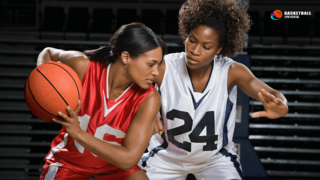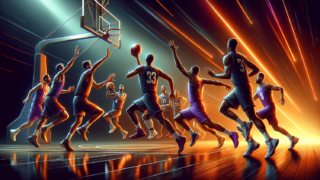
Why Do Basketball Players Wear Rubber Bands on Their Knees?
Written by: Basketball Universe
Last updated:

As basketball enthusiasts, we often marvel at the sheer power, agility, and finesse with which players glide across the court. One accessory that seems to be ever-present on these ballers’ knees is the enigmatic rubber band. If you’ve ever wondered what purpose it serves or if it’s just a fashion statement, you’ve come to the right place! In this fun and professional blog post, we’ll delve into the intriguing world of rubber bands for basketball players, exploring their functionality, benefits, and popularity both on and off the court. So, let’s bounce right into the action and find out why those rubber bands are truly ‘essential gear’ for hoop stars!
Why Do Basketball Players Wear Rubber Bands on Their Knees?
Basketball players wear rubber bands on their knees primarily for functional reasons. These rubber bands, also known as knee sleeves or compression bands, provide support to the knee joint, help to alleviate pain, prevent injuries, and aid in recovery after intense physical activity. Additionally, they improve blood circulation and keep the joints warm, leading to increased flexibility and reduced muscle stiffness during the game.
The Multifaceted Role of Rubber Bands in Basketball Players’ Knees
Many basketball players choose to wear rubber bands, also known as knee sleeves, compression bands or braces, on their knees to gain a variety of benefits. From injury prevention to pain reduction, these bands play a significant role in the lives of hoop stars. Let’s take a closer look at the different ways rubber bands contribute to a player’s performance and well-being. Buckle up, because we’re going in deep!
The Science Behind Rubber Bands and Compression
Compression’s Impact on Performance
To better understand why basketball players wear rubber bands on their knees, we must first explore the principle of compression. Applying pressure to a specific area of the body, such as a joint, can have various positive effects on an individual’s physical performance. Many athletes, including basketball players, wear compression garments for muscular stability, reduced muscle fatigue, and enhanced proprioception (awareness of body position).
Blood Flow and Circulation
Compression can have a noticeable impact on an athlete’s blood flow and circulation. When a rubber band or compression sleeve squeezes the knee, it increases pressure in the blood vessels, leading to improved circulation. This enhanced blood flow can supply muscles with increased oxygen and nutrients, leading to better muscle function during high-intensity activities like basketball games.
Injury Prevention and Pain Reduction
Supporting the Knee Joint
Injury prevention is one of the main reasons many basketball players wear rubber bands on their knees. The knee is a hinge joint composed of the femur, tibia, and patella, held together by muscles, tendons, and ligaments. During the game, the knee endures a lot of stress from jumping, landing, pivoting, and rapid changes of direction. Wearing a rubber band or knee sleeve can provide additional support to the knee joint, helping prevent injuries such as sprains, strains, and dislocations.
Reducing Pain and Inflammation
Rubber bands can also help reduce pain and inflammation in the knee joint. Many basketball players face chronic pain issues such as patellar tendinitis, also known as jumper’s knee, which can be alleviated by wearing a rubber band or knee sleeve. The compression provided by such an accessory can reduce inflammation and alleviate pain, allowing players to comfortably enjoy the game despite any nagging injuries.
Recovery Boost After a Grueling Game
Aiding Muscle Recovery
Basketball games can be intense and demanding, leaving players with sore muscles and achy joints. Many athletes have found that wearing rubber bands or compression sleeves on their knees accelerates their recovery process. The compression helps blood flow back to the heart, flushing out waste products like lactic acid and promoting muscle relaxation. With quicker muscle recovery, players can bounce back and hit the court again in no time.
Minimizing Post-Game Swelling
Swelling after a hard-fought game is a common issue faced by athletes. When a basketball player wears rubber bands on their knees, it can help to manage swelling by encouraging improved lymphatic drainage. The compression provided by the rubber band squeezes the superficial veins, helping to move the lymphatic fluid through the body, promoting reduced swelling and faster healing.
Keeping the Joints Warm and Limber
Maintaining Joint Warmth
A warm joint is a happy joint! Playing basketball requires exceptional flexibility and mobility within the knee joint. Wearing rubber bands or compression sleeves helps keep the joint warm by trapping body heat within the area. This warmth is useful for basketball players since it can help prevent muscle stiffness and reduce the risk of injury on cold and drafty courts.
Enhancing Flexibility
Increased flexibility is another often-overlooked benefit of wearing rubber bands on the knees. Due to the increased blood flow mentioned earlier, the muscles and tendons in the knee joint are more supple and pliable. This added flexibility allows basketball players to execute pivots, cuts, and jumps with more ease, potentially leading to improved performance on the court.
Boosting Confidence and Style
Psychological Benefits
While rubber bands have many physiological benefits, they can also provide psychological benefits. Many athletes believe that wearing compression gear gives them a mental edge – a perception that they’re better equipped to perform at their highest level. This increased confidence can result from feeling supported during intense movements or simply believing in the advantages compression gear can offer. A more confident player often performs better, adding another reason to consider wearing rubber bands on the knees.
Style Points
Last but not least, let’s address the undeniable fact that rubber bands and knee sleeves give basketball players some added style points. While they do serve a practical purpose, they’ve also become a popular accessory among professional and amateur players alike. From bold colors and unique patterns to brand endorsements, rubber bands have evolved into a fashionable statement on the court.
So there you have it – a deep dive into the versatile world of rubber bands and their role in a basketball player’s journey. Whether it’s offering valuable physical support or delivering a confidence boost, these simple yet highly effective accessories will continue to be a staple in the game for years to come. And who knows, maybe even you’ll be rocking a rubber band on your knee during your next pick-up game!
Choosing the Right Rubber Band for Your Needs
Now that we’ve explored the numerous benefits of wearing rubber bands on the knees, it’s time to discuss how to select the right type of rubber band (knee sleeve or compression band) for your specific needs. With a plethora of options available in the market, making the right choice may seem overwhelming. To streamline the process, let’s take a look at the factors you should consider to find the perfect knee accessory for you.
Material and Construction
The first factor you need to consider when choosing a rubber band or knee sleeve is the material and construction. Most knee sleeves are made of materials like neoprene, spandex, polyester, or a combination of these, offering varying levels of support, compression, elasticity, and breathability. Be sure to choose a material that is comfortable, durable, and fits snugly without restricting movement.
Size and Fit
Getting the right size and fit is crucial for the effectiveness and comfort of a rubber band or knee sleeve. Too tight, and it can restrict blood flow; too loose, and it won’t provide the necessary support. To find your size, measure the circumference of your leg just above the knee, then refer to the manufacturer’s sizing chart. The correct size will ensure that your selected rubber band works as intended.
Level of Compression and Support
Knee sleeves and rubber bands offer various levels of compression and support, which can range from mild to heavy-duty. The level of compression should be determined based on your unique needs, such as injury prevention, recovery purposes, or performance enhancement. For instance, if you’re predominantly looking for support during high-intensity activities like basketball games, consider medium to high-level compression.
Comfort and Breathability
While the primary focus might be on support and compression, do not forget the importance of comfort and breathability. Basketball games can be long and rigorous, and wearing a comfortable, breathable rubber band or knee sleeve will ensure that you can focus on the game without any distractions. Look for features such as moisture-wicking materials and ventilation zones to keep your knees dry and comfortable throughout the game.
Expert Tips for Wearing and Caring for Your Rubber Bands
Once you’ve selected the right rubber band or knee sleeve, it’s essential to know how to wear and care for it. Proper use and maintenance will prolong the life of your accessory and ensure its continued effectiveness. Here are some expert tips to help you get the most out of your rubber bands:
Wearing Your Rubber Bands Correctly
Make sure you wear your rubber bands or knee sleeves correctly for maximum effect. They should be snug yet comfortable, with the seams aligned along the sides of your leg. Worn correctly, these bands should not bunch or roll down during your game. Additionally, ensure that the rubber bands do not impede your natural movements or feel too restrictive.
Cleaning Your Rubber Bands
Regular cleaning of your rubber bands or knee sleeves will prevent the accumulation of bacteria, odors, and dirt. Follow the manufacturer’s guidelines for cleaning, which typically involve hand washing with mild soap and warm water. Air-dry your rubber bands and avoid placing them under direct sunlight or using a dryer to prevent any damage or deformation.
Inspect Your Rubber Bands Periodically
Lastly, inspect your rubber bands or knee sleeves periodically for any signs of wear and tear. Although these accessories are built for durability, they will eventually require replacement. Look for any damage, over-stretching, or loss of elasticity to replace them promptly and ensure they continue providing the necessary support and protection.
By taking these tips into consideration, you will be well-equipped to select, wear, and care for your rubber bands or knee sleeves, enhancing your overall basketball experience. Remember, these simple yet effective accessories are not just fashion statements, they play a vital role in protecting and supporting your knees as you showcase your skills on the court. Happy hooping!
Frequently Asked Questions (FAQs)
As a comprehensive resource, we’ve compiled a list of frequently asked questions (FAQs) about rubber bands and knee sleeves for basketball players. These answers, provided in an NLP style, will address any lingering queries you may have.
1. Are rubber bands necessary for all basketball players?
No, rubber bands are not a necessity for all basketball players. However, wearing them offers several benefits, including injury prevention, pain reduction, joint support, and improved performance. Players who frequently experience knee issues or want additional support may consider wearing them.
2. Can rubber bands cause any harm to the knees?
Incorrectly sized or overly tight rubber bands could lead to circulation and mobility issues. To avoid any potential harm, it’s essential to choose the appropriate size, fit, and level of compression for your specific needs.
3. How long do rubber bands last?
The lifespan of rubber bands varies depending on usage, material, and care. You can prolong their life by cleaning and maintaining them regularly. However, they will eventually need to be replaced due to wear and tear or loss of elasticity.
4. Can I wear rubber bands all day long?
Wearing rubber bands all day long is generally not recommended as it may cause discomfort and limit circulation. They are best suited for physical activities, such as basketball games or training sessions, where the benefits are most needed.
5. Is it advisable to sleep with rubber bands on?
No, it is not advisable to sleep with rubber bands on, as they may restrict blood flow, cause discomfort, and limit proper joint movement during sleep, which could lead to other issues.
6. Can I wear rubber bands on both knees?
Yes, you can wear rubber bands on both knees. Many athletes choose to do so for bilateral support and injury prevention, and to maintain their joint flexibility and mobility.
7. How often should I clean my rubber bands?
It’s recommended to clean your rubber bands after each use, especially if you’ve been sweating. This will ensure that they remain bacteria-free, odor-free, and in good condition for an extended period.
8. Can rubber bands be a preventive measure against knee injuries?
Rubber bands can serve as a preventive measure against knee injuries by providing support, stability, and warmth to the joint during high-intensity physical activities like basketball games.
9. Can wearing rubber bands help my existing knee injury?
While rubber bands can help alleviate pain and inflammation associated with some knee injuries, it’s essential to consult a medical professional for proper guidance on addressing specific conditions.
10. Are there any alternatives to rubber bands for knee support?
Alternatives to rubber bands for knee support include athletic tapes, knee straps, and knee braces. However, it’s crucial to determine which option best suits your needs and consult with a medical professional, if necessary.
11. Can I use rubber bands for sports other than basketball?
Yes, rubber bands are versatile and can be used for various sports that require knee support and stability, such as volleyball, running, and soccer, among others.
12. Can I wear rubber bands under my sports gear?
You can wear rubber bands under your sports gear, as long as they don’t restrict your movement or cause discomfort. Ensure that your sports gear fits over the rubber bands without creating additional pressure.
13. Do rubber bands really provide psychological benefits?
While it may vary from person to person, many athletes claim that wearing rubber bands gives them a mental edge, boosts confidence, and helps them feel better prepared to perform at their highest level.
Featured Posts
- No pillar pages found.




